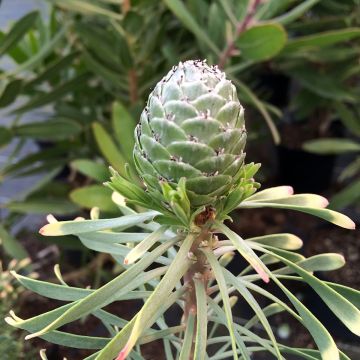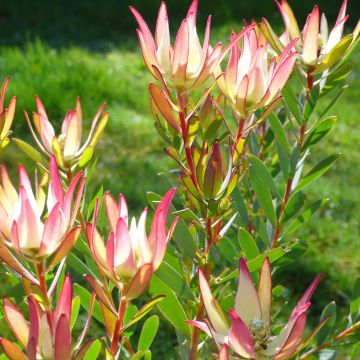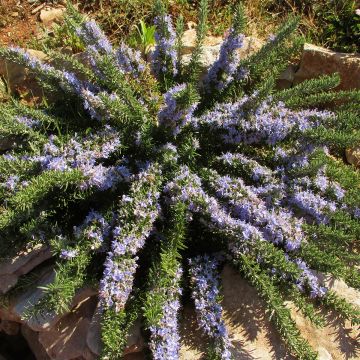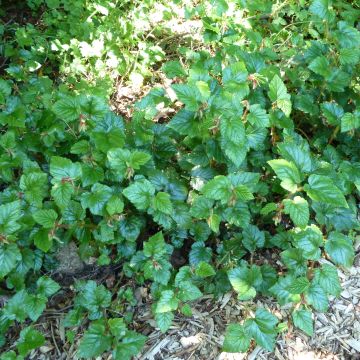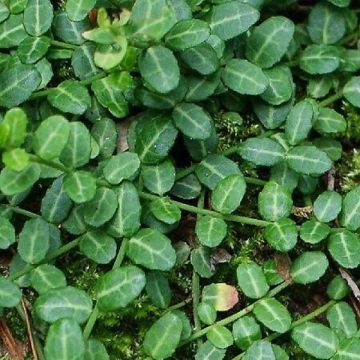

Leucadendron salignum x laureolum Safari Goldstrike - Conebush
Leucadendron salignum x laureolum Safari Goldstrike - Conebush
Leucadendron salignum x laureolum 'Safari Goldstrike' (Safari series)
Safari Sunset, Conebush
This plant carries a 24 months recovery warranty
More information
We guarantee the quality of our plants for a full growing cycle, and will replace at our expense any plant that fails to recover under normal climatic and planting conditions.
From €5.90 for pickup delivery and €6.90 for home delivery
Express home delivery from €8.90.
Does this plant fit my garden?
Set up your Plantfit profile →
Description
The Leucadendron 'Safari Goldstrike' is an ornamental bush native to South Africa that amazes with its golden yellow floral bracts, a spring flowering that brightens up coastal gardens. Used for creating colourful beds in favourable climate, or on an exotic terrace, this young plant is also extensively grown in New Zealand for cut flowers. The Leucadendron are most often grown in large pots, as it is essential to store them away at the first frosts.
The Leucadendron 'Safari Goldstrike' is a hybrid (cross-breeding between Leucadendron laureolum and L. strobolinum), selected for its upright habit and spectacular flowering. All these plants belong to the family of proteas and are native to the Cape Province in South Africa. 'Safari Goldstrike' can reach between 1.5 and 2 m in height with a similar spread. Grown in a pot, it will rarely exceed 1.20 m. Its evergreen, elliptical, slightly silvery leaves are approximately 5 to 8 cm long. The plant usually flowers from April to June in our climate. Large bright yellow bracts surround the floral cones, which are actually small decorative structures rather than typical flowers. The sturdy red stems provide a magnificent contrast with the colourful foliage and bracts.
The Leucadendron naturally grows in South African provinces with a Mediterranean-type climate, where it has adapted to drought conditions. It thrives only in sandy or loamy soil, with a slightly acidic to neutral pH. Hardy down to -5 °C at the most, it is only grown in the ground in climates where frosts are rare. Like Proteas, Leucadendrons are peculiar plants that need fire to break seed dormancy. However, unlike them, there are male and female plants.
The Leucadendron 'Safari Goldstrike' is planted in dry gardens, Mediterranean beds, or in large pots on terraces. In beds, it pairs well with plants like agapanthus, shrubby euphorbias (Euphorbia characias), and ornamental grasses like Miscanthus. It is great for creating colour and texture contrasts due to its yellow bracts and red stems. Versatile, it can also be pruned to make low hedges or more structured shapes in landscaping. In New Zealand, the flowers are highly valued in floristry, as they last long in bouquets while adding a beautiful exotic touch.
Report an error about the product description
Plant habit
Flowering
Foliage
Botanical data
Leucadendron
salignum x laureolum
'Safari Goldstrike' (Safari series)
Proteaceae
Safari Sunset, Conebush
Leucadendron Goldstrike
Cultivar or hybrid
Other Leucadendron
Planting and care
Plant Leucadendron 'Safari Goldstrike' preferably in spring, or in autumn in very mild climates, in a very sunny and wind-sheltered location. This plant requires a light, well-drained, filtering, nitrogen-poor, slightly acidic soil. A mix of leaf soil, a little heather soil, and river sand seems appropriate. Once well rooted, it tolerates drought. Leucadendrons, like proteas, are sensitive to excess phosphates and nitrates, so it is necessary to avoid giving too much fertiliser, or even not giving any at all. While adult plants tolerate brief frosts of around -5°C in dry soil, young specimens, on the other hand, should be protected from frost during their first years, in a frost-free room in cool climates or under winter protection in regions with mild winters. This plant flowers after approximately 4 to 5 years of cultivation from sowing. For indoor cultivation, it is important to ensure good room ventilation and avoid watering with hard water.
Planting period
Intended location
Care
This item has not been reviewed yet - be the first to leave a review about it.
Evergreen shrubs
Haven't found what you were looking for?
Hardiness is the lowest winter temperature a plant can endure without suffering serious damage or even dying. However, hardiness is affected by location (a sheltered area, such as a patio), protection (winter cover) and soil type (hardiness is improved by well-drained soil).

Photo Sharing Terms & Conditions
In order to encourage gardeners to interact and share their experiences, Promesse de fleurs offers various media enabling content to be uploaded onto its Site - in particular via the ‘Photo sharing’ module.
The User agrees to refrain from:
- Posting any content that is illegal, prejudicial, insulting, racist, inciteful to hatred, revisionist, contrary to public decency, that infringes on privacy or on the privacy rights of third parties, in particular the publicity rights of persons and goods, intellectual property rights, or the right to privacy.
- Submitting content on behalf of a third party;
- Impersonate the identity of a third party and/or publish any personal information about a third party;
In general, the User undertakes to refrain from any unethical behaviour.
All Content (in particular text, comments, files, images, photos, videos, creative works, etc.), which may be subject to property or intellectual property rights, image or other private rights, shall remain the property of the User, subject to the limited rights granted by the terms of the licence granted by Promesse de fleurs as stated below. Users are at liberty to publish or not to publish such Content on the Site, notably via the ‘Photo Sharing’ facility, and accept that this Content shall be made public and freely accessible, notably on the Internet.
Users further acknowledge, undertake to have ,and guarantee that they hold all necessary rights and permissions to publish such material on the Site, in particular with regard to the legislation in force pertaining to any privacy, property, intellectual property, image, or contractual rights, or rights of any other nature. By publishing such Content on the Site, Users acknowledge accepting full liability as publishers of the Content within the meaning of the law, and grant Promesse de fleurs, free of charge, an inclusive, worldwide licence for the said Content for the entire duration of its publication, including all reproduction, representation, up/downloading, displaying, performing, transmission, and storage rights.
Users also grant permission for their name to be linked to the Content and accept that this link may not always be made available.
By engaging in posting material, Users consent to their Content becoming automatically accessible on the Internet, in particular on other sites and/or blogs and/or web pages of the Promesse de fleurs site, including in particular social pages and the Promesse de fleurs catalogue.
Users may secure the removal of entrusted content free of charge by issuing a simple request via our contact form.
The flowering period indicated on our website applies to countries and regions located in USDA zone 8 (France, the United Kingdom, Ireland, the Netherlands, etc.)
It will vary according to where you live:
- In zones 9 to 10 (Italy, Spain, Greece, etc.), flowering will occur about 2 to 4 weeks earlier.
- In zones 6 to 7 (Germany, Poland, Slovenia, and lower mountainous regions), flowering will be delayed by 2 to 3 weeks.
- In zone 5 (Central Europe, Scandinavia), blooming will be delayed by 3 to 5 weeks.
In temperate climates, pruning of spring-flowering shrubs (forsythia, spireas, etc.) should be done just after flowering.
Pruning of summer-flowering shrubs (Indian Lilac, Perovskia, etc.) can be done in winter or spring.
In cold regions as well as with frost-sensitive plants, avoid pruning too early when severe frosts may still occur.
The planting period indicated on our website applies to countries and regions located in USDA zone 8 (France, United Kingdom, Ireland, Netherlands).
It will vary according to where you live:
- In Mediterranean zones (Marseille, Madrid, Milan, etc.), autumn and winter are the best planting periods.
- In continental zones (Strasbourg, Munich, Vienna, etc.), delay planting by 2 to 3 weeks in spring and bring it forward by 2 to 4 weeks in autumn.
- In mountainous regions (the Alps, Pyrenees, Carpathians, etc.), it is best to plant in late spring (May-June) or late summer (August-September).
The harvesting period indicated on our website applies to countries and regions in USDA zone 8 (France, England, Ireland, the Netherlands).
In colder areas (Scandinavia, Poland, Austria...) fruit and vegetable harvests are likely to be delayed by 3-4 weeks.
In warmer areas (Italy, Spain, Greece, etc.), harvesting will probably take place earlier, depending on weather conditions.
The sowing periods indicated on our website apply to countries and regions within USDA Zone 8 (France, UK, Ireland, Netherlands).
In colder areas (Scandinavia, Poland, Austria...), delay any outdoor sowing by 3-4 weeks, or sow under glass.
In warmer climes (Italy, Spain, Greece, etc.), bring outdoor sowing forward by a few weeks.


































